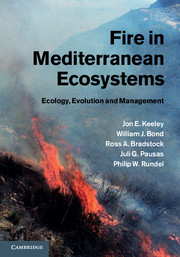Section II - Regional patterns
Published online by Cambridge University Press: 05 January 2012
Summary
Regional patterns
Mediterranean-type climates (MTC) comprise a diverse array of woody, herbaceous, and even succulent vegetation types in each of the five regions. Shrublands are universal across all MTC regions and have been the main focus of past comparative studies; however, woodlands and forests are of great interest in understanding drivers in these ecosystems. InSection IIwe examine in detail the intraregional patterns of variation in vegetation types and the ecological role fire plays in each of the five regions. We are concerned with the degree to which similar environments have converged on similar fire regimes and those factors responsible for divergence. A boiler-plate approach of topics covered in each region is not the appropriate metaphor here as each region presents very different problems associated with different landscape histories and fire responses. The nominate region, the Mediterranean Basin, has such an extraordinarily long and intensive human history that landscapes exist as a palimpsest with ecological patterns overriding signatures from earlier uses. Crown fires dominate all MTC regions but California is unique among these in having substantial forests of tall conifers prone to surface fire regimes, with different trajectories of trait evolution and fire management impacts. Central Chile exhibits patterns best interpreted as a fading fire regime, once quite evident but, like a dying star, it has been extinguished by the Late Miocene completion of the Andean uplift that now blocks ignition sources due to lightning. The Western Cape of South Africa is considered to have the climate and geology sufficient to support forests, but these are extremely limited and restricted to narrow refugia from fire. Southern Australia is phenomenal in that sclerophyllous-leaved mediterranean-type vegetation (MTV) covers much of the southern third of the continent, despite the lack of a MTC from middle Victoria to New South Wales in the southeastern corner of the continent.
- Type
- Chapter
- Information
- Fire in Mediterranean EcosystemsEcology, Evolution and Management, pp. 81 - 82Publisher: Cambridge University PressPrint publication year: 2011



